Cast Iron Vs. Stainless Steel – Which Is Better?

Choosing pans that will last is an important consideration when making a purchase, and you might be wondering whether cast iron or stainless steel is the better option. When it comes to cookware, the battle between traditional and modern materials rages on. Cast iron, with its rich history dating back centuries, has had a resurgence in recent years. Stainless steel, a marvel of modern metalworking, is comparatively newer but has many proponents.
Each material possesses unique qualities, making them both coveted choices among home cooks and professional chefs alike. We spoke to four experts to get the answers you need. From speed of heating and reactivity to cleaning and care, there's a lot to think about when comparing stainless steel and cast iron. Ultimately, there may not be a single best choice, but there's probably a best choice for you.
We'll dissect the strengths and weaknesses of the two materials with help from our culinary experts, so you can make an informed decision about which one reigns supreme in the kitchen. Let's unravel the sizzle, the sear, and the simmer, and discover the ultimate champion in the timeless debate of cast iron versus stainless steel.
Read more: The Most Useless Cooking Utensils, According To Chefs
Seasoning
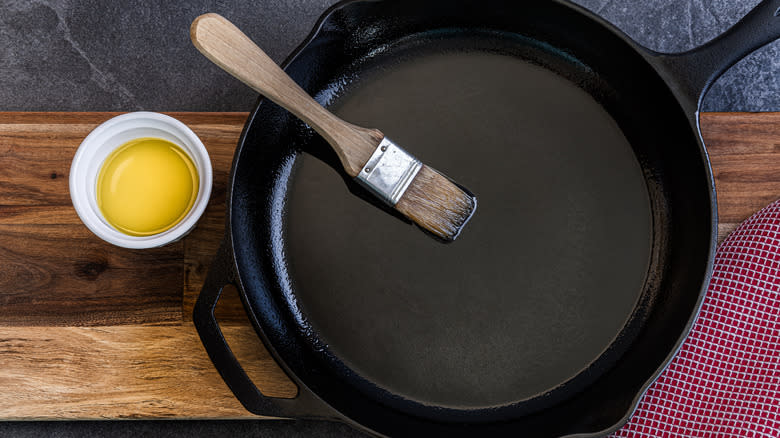
Seasoning refers to the process of creating a natural, non-stick coating on the surface of cast iron pans. This coating is formed by heating oil or fat in the pan, which bonds with the iron to create a protective layer. Seasoning cast iron not only prevents rusting but also gives this type of cookware its characteristic non-stick properties. The process involves polymerization, causing the oil to form a hard, slick surface on the iron, which makes it easier to cook with and clean.
Pastry chef and recipe developer Emily Laurae Carter highlights, "Proper seasoning is the cornerstone of an effective cast iron pan." Meanwhile, Kara Myers — recipe developer and food blogger at Sweetly Splendid — shares advice for seasoning your cast iron pans: "Seasoning a cast iron is super simple, but one tip that I highly recommend that often gets skipped is buffing the oil until it no longer looks greasy before putting it in the oven. By buffing it in, you can avoid little sticky spots."
The difference between stainless steel and cast iron in this department is that cast iron needs seasoning (unless its interior is enamel-coated), while stainless steel does not. You can buy cast iron pans that are pre-seasoned, but even then, they can usually do with an extra layer or two of seasoning to improve their non-stick coatings.
Non-Stick Properties

According to Farwin Simaak, a food blogger at Love and Other Spices, "When properly seasoned, [cast iron pans] develop a natural non-stick coating." This allows you to cook foods that might otherwise stick to the surface of the pan.
On the flip side, stainless steel doesn't have a non-stick coating, so you need to use plenty of oil and heat it just right to prevent sticking. Still, there are some foods that are hard to cook in stainless steel pans. "I find it difficult to cook eggs and fish," says Myers of stainless steel pans. "Because they are so finicky with food sticking, you can usually end up with a torn egg or demolished fish if it hasn't been heated and oiled at just the right times."
However, cast iron isn't without its faults in this department. When you initially buy a cast iron pan, it can take a little while to develop the seasoning and technique so your food doesn't stick. "When first starting to use your cast iron pan it's easiest to cook with fatty foods that are less likely to stick," explains Silvia Hermanny, a food and lifestyle influencer.
This is especially important with skillets and frying pans, where non-stick properties are more useful. Saucepans, stockpots, and Dutch ovens are usually used for boiling foods like pasta and veggies and for simmering saucier dishes, such as soups and stews, so they don't really need to be non-stick.
Cooking And Performance
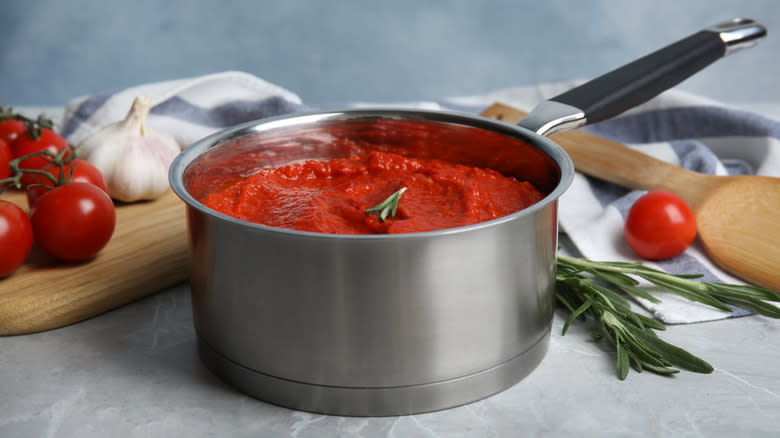
Both cast iron and stainless steel have their pros and cons when it comes to cooking and performance. Myers notes that cast iron is particularly good for searing, slow cooking, and baking because it retains heat nicely and is naturally non-stick (assuming it's seasoned properly).
But, some foods are harder to cook in cast iron pans. "While cast iron is versatile, acidic foods like tomatoes or citrus-based dishes can strip the seasoning and potentially react with the metal," explains Carter. "I'd opt for a stainless steel pan in these cases."
As for stainless steel, Simaak likes that "it's not reactive and you can cook acidic food or any kind of food in it." However, she also notes that "eggs and other sticky foods are a bit challenging to cook in stainless steel as they tend to stick especially if the pan isn't well-heated or properly oiled."
Stainless steel is generally easier to work with for acidic foods, as well as tasks that involve sauces and deglazing. Cast iron excels in high-heat cooking, baking, and slow cooking but requires careful maintenance, especially when it comes to acidic foods. Each material has its strengths, so the choice depends on the specific dish you're preparing and your preferences.
Heating Speed And Retention
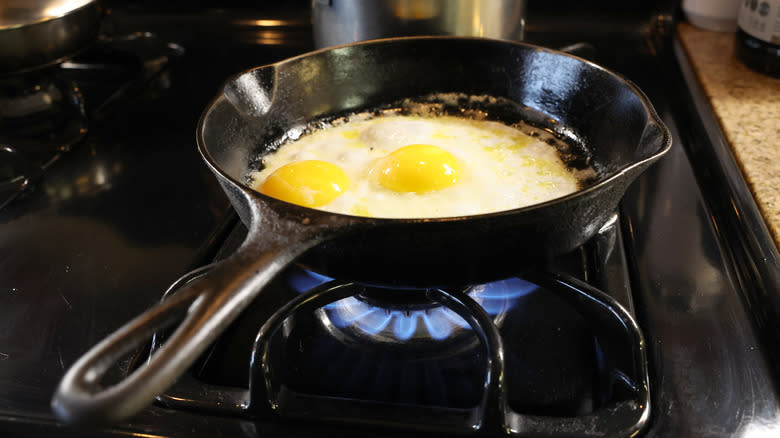
While the experts we spoke with agree that cast iron pans are known for their excellent heat retention, they warm up relatively slowly compared to some other materials because of their density and low heat conductivity. However, once they are hot, they maintain that heat very well, making them ideal for tasks that require a steady, even temperature, such as searing and slow cooking. Be careful though, because cast iron takes a while to cool down once it's hot.
Stainless steel pans, on the other hand, heat up relatively quickly. They have a lower density than cast iron, so they respond faster to changes in temperature. This characteristic makes them suitable for tasks that require promptly adjusting heat levels, such as sauteing delicate foods or making sauces. The downside is that they don't retain heat as effectively, which poses some challenges. For instance, achieving a good sear requires high, consistent heat. Stainless steel pans can lose heat quickly and therefore might not maintain the necessary temperature for a proper sear.
Heat Distribution
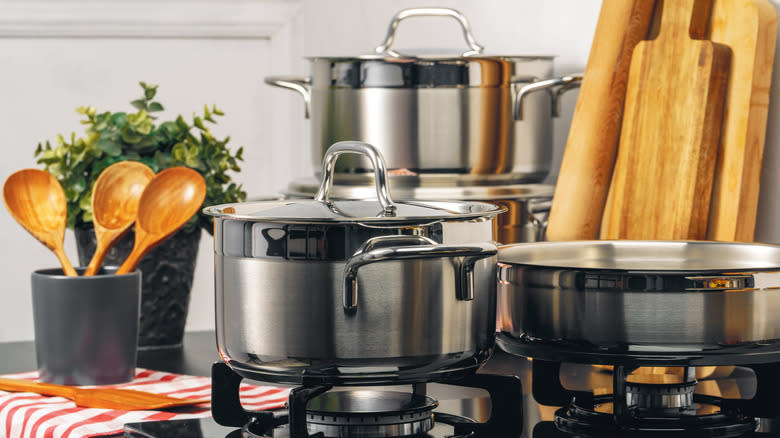
There's a common misconception about cast iron's heat distribution and evenness of heating. Many people believe that the material heats extremely evenly, but in fact, it produces specific hot spots straight over the burners. However, because of the way it retains heat, once the pan has fully warmed up, it spreads the heat evenly.
For optimal results, start by heating a cast iron pan for 10 minutes and rotating it on the burner to achieve even temperature distribution. Carter and Hermanny both praise how evenly cast iron pans cook — even if, technically, the heat distribution properties are poor.
Stainless steel heats more quickly than cast iron and therefore, is quicker to evenly distribute heat with fewer hot spots. Fully clad stainless steel does this best because it has a core made of a more conductive metal, such as aluminum, which speeds up heating and allows for more even heat distribution.
Weight
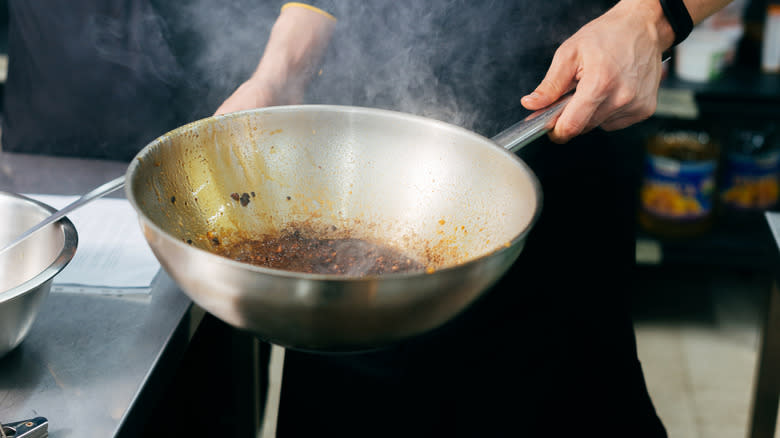
The pan's weight can be an important factor to consider, especially for individuals with mobility issues or those who do a lot of cooking that requires frequently lifting and moving equipment. Cast iron pans are made entirely of thick cast iron, which is a dense, heavy material -- even smaller pans can be quite hefty. While the weight provides excellent heat retention and makes these pans exceptionally sturdy, they can be challenging for some people to handle, especially when they're full of food. Simaak and Carter both note the weight of cast iron as a potential drawback.
Stainless steel pans are much lighter in comparison. Myers remarks that they are "lightweight, which may be a better option for those with grip strength or wrist issues." The material itself is not as dense as cast iron, so pans often have an aluminum or copper core to enhance heat distribution. Regardless, stainless steel is lighter than cast iron, making these pans significantly lighter overall. For this reason, they are generally easier to handle and usually preferred in professional kitchens for their lighter weight. If you regularly use your pans for tasks that involve a lot of tossing and stirring, stainless steel is the way to go.
Durability
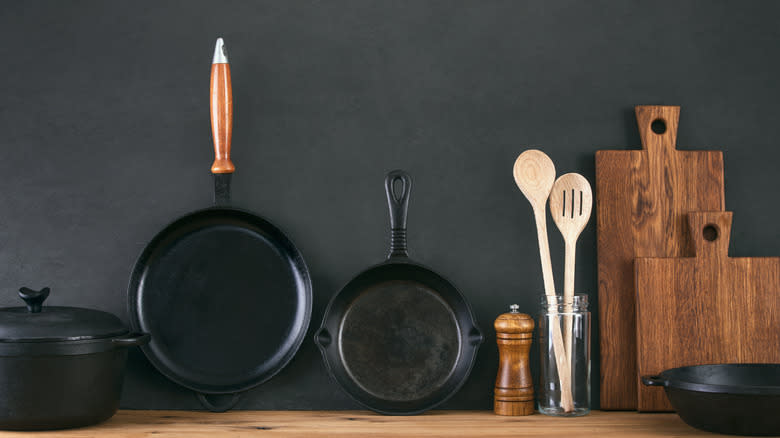
Neither cast iron nor stainless steel is particularly flimsy, but thanks to its heavy-duty material, cast iron usually comes out on top. "Cast iron, with its robust and sturdy nature, tends to have a longer lifespan," explains Carter. "When properly cared for, it can serve generations in the kitchen," she continues.
Myers expands on this and says, "Cast iron and stainless steel are both very durable. They each have their own durability areas. Stainless steel is more corrosion resistant, but more likely to warp. Cast iron is heavy and durable, but has the possibility of rusting and cracking."
Simaak also comments on the durability of stainless steel pans: "They don't chip, stain, or rust and last a long time," she remarks. However, she concedes that they can scratch easily and notes that you should take care when using metal utensils in stainless steel pans.
Well-maintained cast iron pans can last for generations, even becoming family heirlooms. However, stainless steel is also durable and requires less careful care, so it's more likely to survive without mishap.
Cleaning And Care
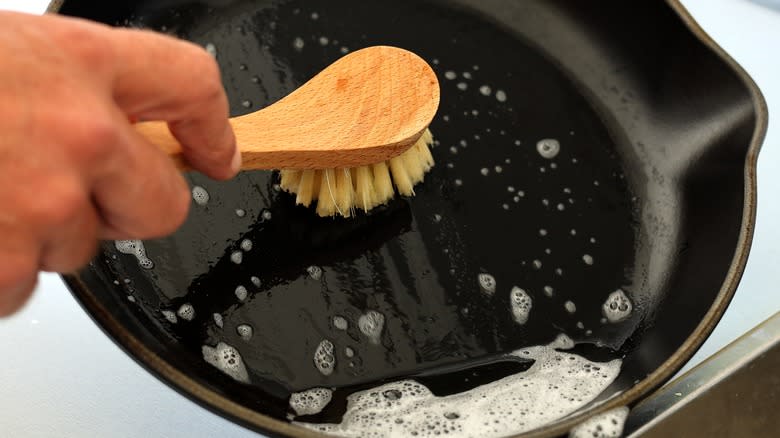
Cleaning and caring for a cast iron pan is regularly mentioned, but is it really as challenging as people think? According to Hermanny, "Cast iron skillets can rust easily so it's important to take proper care. You do not want to let the cast iron stay wet, soak overnight, or put it in the dishwasher." Meanwhile, Myers notes, "Cast iron requires oiling after drying before storage. I do find that stuck on food is much easier to remove from cast iron than stainless steel though."
So, there are certainly pros and cons to maintaining and cleaning cast iron pans. But, what about using soap? While some people say that it strips away the seasoning, this isn't actually true. The oil that's seasoning your cast iron pan is polymerized to create a hard, slick surface, so it would take more than a little dish soap to get rid of it.
Nevertheless, Carter points out that "stainless steel is generally more straightforward to care for." She likes that it's dishwasher-safe, as does Simaak, who's also of the opinion that stainless steel is easier to clean and maintain.
Ultimately, both materials have advantages and disadvantages when it comes to maintenance. Cast iron requires a little more care overall, but it's easier to clean when food gets stuck to it. Stainless steel doesn't need any special care, but it can be tricky to scrub off food when it gets seriously stuck.
Reactivity
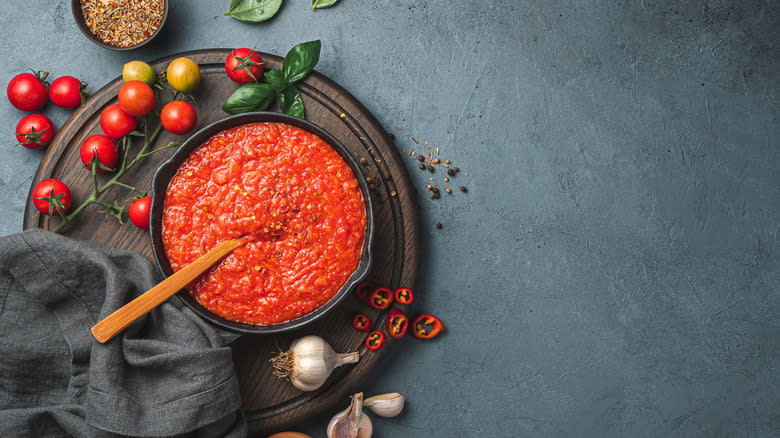
The difference between cast iron and stainless steel cookware is that the former is reactive while the latter isn't. By "reactive," we mean that cast iron can react with certain foods, especially if they are acidic. For example, tomatoes, vinegar, and citrus fruits can react with the iron in the pan, imparting a metallic taste to the food. This is particularly noticeable in dishes that are cooked for a long time.
Aside from changes in the taste and color of the food, this can also cause the pan to leach small amounts of iron. While iron is an essential mineral the body needs, excessive intake can be harmful, especially for individuals with iron-related health conditions. It's worth noting that this doesn't apply to cast iron pans that are coated with enamel on the inside.
On the other hand, stainless steel is non-reactive, so it doesn't alter the taste, color, or smell of the food being prepared. This property is particularly important when cooking delicate dishes where the natural flavors need to be preserved. Stainless steel is ideal if you're working with acidic ingredients like tomatoes, vinegar, and citrus fruits. Unlike cast iron, stainless steel won't cause these foods to pick up a metallic taste or change color while cooking.
Oven-safety
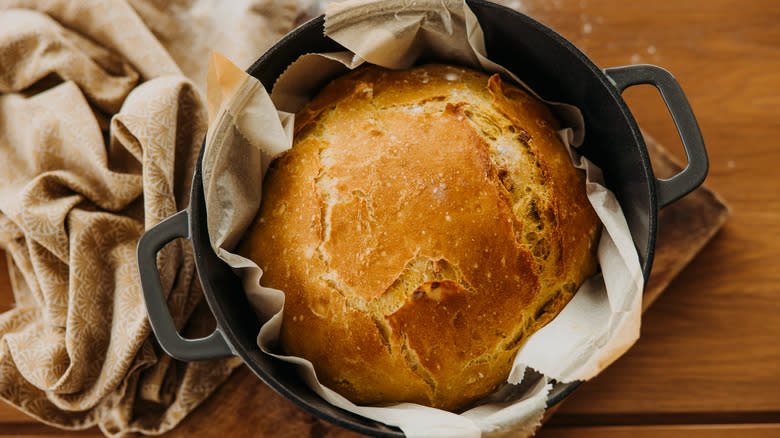
Cast iron is always oven-safe, while stainless steel cookware may or may not be, depending on a number of factors. This property of cast iron pans is one of the things Myers loves about them. "They're really great going from stove to oven quickly and bake well," she says. Carter agrees and explains that as a pastry chef, cast iron is her go-to option for certain baked goods.
The versatility that comes from being able to transfer a dish from the stovetop to the oven is very convenient. It makes it easier to cook certain dishes, like cassoulet or stew, that start on the stovetop and finish in the oven. It's also great if you're baking items from scratch. For instance, you can make bread in cast iron Dutch ovens or pizza in cast iron skillets.
Stainless steel pans should be oven-safe, in theory, but always check the manufacturer's instructions or labels first. For example, handles can be an issue as they are sometimes made of materials like plastic or rubber, which may not be safe for high-temperature oven use. You should also check if the lid is oven-safe. Some are, some aren't, and some have a maximum oven-safe temperature that is lower than what the pan can withstand.
Price

The cost of both cast iron and stainless steel pans can vary widely depending on several factors, including the brand, size, quality, and additional features. Cast iron pans are often more affordable than high-quality stainless steel pans. Basic cast iron pans, such as those without enamel coating, can be quite inexpensive, making them a budget-friendly option for consumers. Additionally, cast iron pans are known for their durability, so they offer good value for the price. That said, some high-end enameled cast iron pan brands — such as Le Creuset — can be extremely pricey.
While you can find cheap stainless steel pans, they're often of poor quality compared to cast iron at a similar price. Better options tend to be more expensive than most cast iron pans. High-quality stainless steel pans with added features, such as aluminum or copper cores for better heat distribution, can be quite costly. However, stainless steel pans are also durable and resistant to rust and staining, which makes them a long-term investment.
Which Is Better?
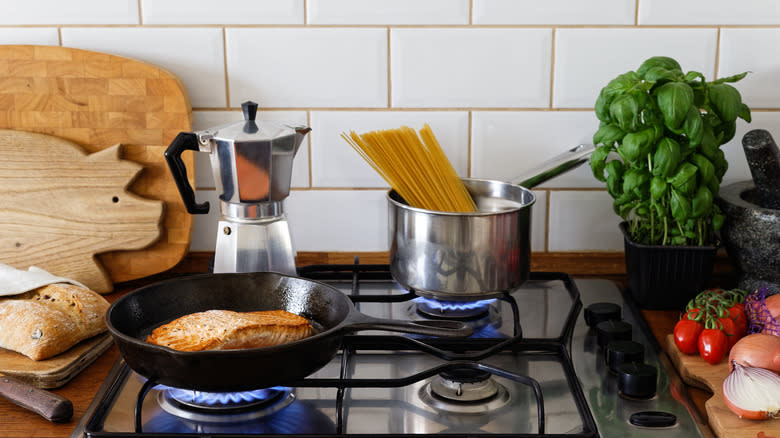
So, which is better — cast iron or stainless steel? The fact is, there's no single easy answer. When we asked our experts, they had mixed views. Both Simaak and Myers told us they go for cast iron. Myers comments, "I personally prefer cast iron pans due to the heat retention and ease of cooking. They're less finicky and allow for a little more relaxed cooking."
On the other hand, Hermanny is team stainless steel. She says, "I personally love stainless steel pans. They are reliable and I think easier to cook a range of foods with." Finally, Carter notes that both have a place in her kitchen. "The best pan often depends on the specific dish I'm creating," she explains.
Effectively, they're both good in their own ways, so it's all about finding the right option to fit your needs. If you don't mind a little extra maintenance and want something exceptionally durable that retains heat well, cast iron is the way to go. But, if you want something light that you can stick in the dishwasher, you'll probably prefer a stainless steel pan. Of course, if you have the budget for it, you might benefit from having both in your kitchen and choosing the best pan for the task at hand.
Read the original article on Mashed.

